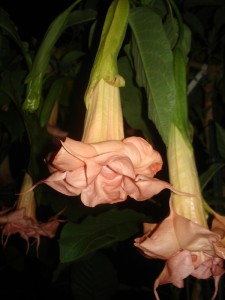When I first started looking for a Brugmansia that had traits I wanted to pass on to a new variety I had in mind, Brugmansia “Sam” wasn’t high on my list. It had a tendency to produce flowers that never opened fully, rotted without blooming if it was above 80 degrees and grew so slowly I thought I’d be sitting on a long, grey beard before it got to bush size. On the plus side, the flower color was superb – a nice smoldery raspberry color with a brownish cast, it threw triples frequently, didn’t lose buds, made fat seed laden pods and it’s leaves were thick and green.
I ruminated over using it in my breeding program, but that rotting-before-bloom thing worried me. As most hybridizers know, touching pollen to a flower means you’re willing to make an investment of at least two years of growing and evaluation before you experience an eventual outcome…and it isn’t a very glorious outcome if you make the wrong decision. I decided the lure of a possible smoldery-raspberry-triple flower was too tempting to pass up, so I dusted a lot of my Brug flowers with Sam pollen.
I got lots of pods, big fat ones with plenty of plump seeds. I sold a pile of them, gave a bunch away and kept about ten per pod for me. I had a good sprout rate. The plants grew well. No problems. My first bloom results were rather startling. Every plant I’d crossed with Sam produced either a double or triple form. Nice. I had hoped crossing Sam (with his tightly packed, hard to expand bloom) with wide-blooming singles would result in a more open flower wih wider skirts that were stacked neatly upon one another. I was right, the resulting flowers performed as if by order.
Here’s a picture of “Sam”. Notice the tight flower form. Lots of skirts stuffed up there. Drink in that color, though! Sweet!

Now let’s take a look at a Creamsickle x Sam cross.

That’s it on the left in the above photo. An orange triple? Yep. An orange triple. It gets better.
Take a look at the photo below – a “Perfect Harmony” x “Sam” cross. A yellow double! Is this getting your interest now? It sure impressed me. You can imagine how excited I was when buds on the other “Sam” crosses appeared.

Here below are two more results – The first is “Earth Angel” x “Sam” a soft, pink triple.

And here’s Rubirosa x Sam. Another soft pink triple.

Well now, we’ve learned something interesting here. “Sam’s” pollen passes the gene that causes multi-form blooms quite easily to whatever single form (or double form) pod parent one crosses it to. Oddly enough, the color of the parent flower is retained or becomes a pastel of the newly formed multi-form bloom. In other words, as a pollen donor, “Sam” rocks. It produces the kind of “Hot” pollen hybridizers love to work with, as the outcome of cross-pollinations with it’s pollen are MORE predictable than just a “roll of the DNA dice.”
Remember, this is intimate information about the strengths of just one type of pollen from one variety of Brugmansia. Take a look at the list of known cultivars – there are hundreds, and each must become intimately known in order to understand which will bring new and better forms to life. Responsible maintenance of that list is essential for establishing a firm foundation for the work of both current and future hybridizers.



